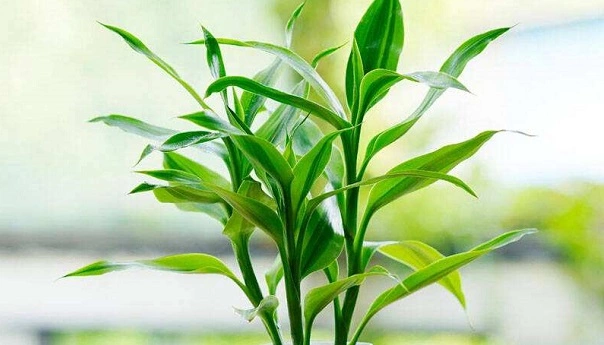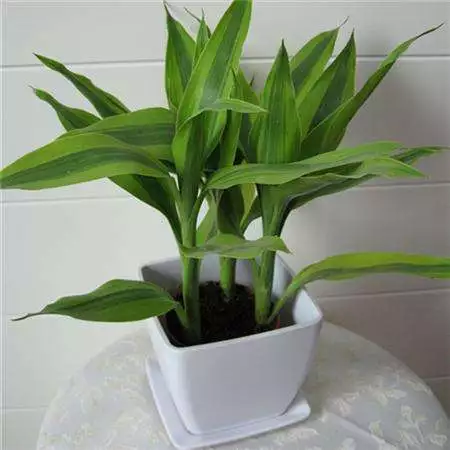How To Save My Root Rot Lucky Bamboo?
Written by Ivy
Dec 21 2021

We can often see lucky bamboos placed in the lobby of hotels and shopping malls. Firstly, the meaning of lucky bamboos is very good, so everyone likes to buy some and put them at home. Looking at long stems and slender leaves will also make people look very comfortable. Moreover, lucky bamboos are not only good-looking but also easy to raise. They can be bought at a very low price in the market, Deeply loved by the public, but lucky Bamboo may have rotten roots, so we must deal with it in time to treat lucky Bamboo.
Why Is My Lucky Bamboo Turning Yellow
If we fertilize lucky bamboo, we should change the water frequently. We should change the water three to five days after fertilization in summer and five to seven days after fertilization in winter. Don't ignore it after fertilization. In particular, some friends like to add some beer, aspirin and rice washing water to lucky bamboo, which can easily lead to root rot.
In addition, when lucky Bamboo has been raised for one or two years, the basin soil will harden and harden due to watering and fertilization. At this time, the basin should be changed in time to improve the drainage and air permeability of the soil, so as to make lucky Bamboo have a good soil environment, which can also reduce the problem of rotten roots.
(Read More: How To Trim Lucky Bamboo?)
In fact, the rotten roots of lucky bamboos are not terrible, because the rich and noble bamboos we bought at the beginning do not have roots. Our treatment method is also very simple, that is, to cut them above the roots, as long as the branches are strong, give them a pair of scissors to cut them off. After cutting them off, give them water again for cutting, and then grow new roots. The new roots grow in the water, Lucky bamboo will be very fast, so this is the best way.
After cutting it off again, we can leave an oblique opening at the bottom of lucky bamboo, properly remove a part of the yellow leaves at the bottom, and then replace it with new water. For water, it's best to use clean water, drop a few drops of rooting liquid in the water, and then insert Fugui bamboo into the water for two or three centimeters, so that we can ensure that the temperature is above 15 degrees after cutting, You can see a little scattered light. Change the water for him every two or three days. Add a little rooting liquid every time you change the water. He will quickly grow new roots in 1 ~ 2 weeks. This is the treatment method of lucky Bamboo rotten roots. After you learn it, you can deal with it directly, because his own root growth speed is very fast.
When we maintain lucky Bamboo in hydroponic culture, we must remember that its roots grow. Every time we change the water in the water, we must drop a few drops of nutrient solution. The nutrient solution can ensure the sufficient supply of nutrients and the normal growth of lucky Bamboo. We must see some light in the maintenance environment, not out of light. The leaves grow thin and long after being out of light for a long time, Moreover, the stem lucky Bamboo rod is also very thin. Don't let the water get dirty. If the water is not clean and there is a little suspended solids, replace the water in time, so as to ensure the clean water quality and the appropriate temperature, lucky Bamboo can grow rapidly and there will be no rotten root problem of lucky Bamboo.
What Does Root Rot Look Like in Lucky Bamboo? Causes Lucky Bamboo Root Rot Wrong WateringFungal InfectionPoor DrainageWrong Pot SizeHow to Save Lucky Bamboo from Root Rot
What Does Root Rot Look Like in Lucky Bamboo?
- Leaves Wilting and Yellowing
- Black, Soft, and Slimy Roots
- Swollen, Browning, and Mushy Stem
- Stunted Growth
- Brown Leaf Tips
- Discolored Leaves
Why Is My Lucky Bamboo Turning Yellow
Causes Lucky Bamboo Root Rot
Wrong Watering
Soil culture lucky Bamboo rotten roots are often mainly due to too much watering, airtight soil and poor drainage, so there is the phenomenon of stuffy roots and rotten roots. Therefore, when maintaining the soil culture lucky Bamboo, remember to adjust the watering frequency according to the actual maintenance situation, and don't water rigidly.If we fertilize lucky bamboo, we should change the water frequently. We should change the water three to five days after fertilization in summer and five to seven days after fertilization in winter. Don't ignore it after fertilization. In particular, some friends like to add some beer, aspirin and rice washing water to lucky bamboo, which can easily lead to root rot.

Fungal Infection
In case of poor growth or abnormal fungal infection in lucky bamboo, it shall be separated and cured in time, and shall not be kept in one container. Even if there are only a few capillary roots that are not easy to find, lucky bamboo already carries a large number of bacteria, which will infect healthy plants, lead to more and more root rot, and finally the whole basin will die.Poor Drainage
Generally, we take care of lucky bamboo indoors. The ventilation conditions are not good. The basin soil would rather be dry than too wet. A little dry will not affect the growth of lucky Bamboo. On the contrary, the basin soil is wet and prone to rotten roots.In addition, when lucky Bamboo has been raised for one or two years, the basin soil will harden and harden due to watering and fertilization. At this time, the basin should be changed in time to improve the drainage and air permeability of the soil, so as to make lucky Bamboo have a good soil environment, which can also reduce the problem of rotten roots.
Wrong Pot Size
Generally, high containers are used for hydroponic lucky bamboos. The water in the container should not be too much, accounting for one third of the height of the container. Especially for containers with small mouth, large depth and large belly or bottom, pay more attention to the amount of water. Otherwise, the underwater oxygen content is insufficient, and lucky bamboo is easy to rot due to hypoxia, resulting in yellow leaves or whole plant death. For hydroponic lucky bamboos, attention should also be paid to the size of the container mouth. Do not plant too many lucky bamboos in a bottle. At least one third of the space should be reserved at the bottle mouth to enhance ventilation. If the lucky Bamboo rod blocks the bottle mouth tightly, it is particularly easy to rot.How to Save Lucky Bamboo from Root Rot
To solve the problem of rotten roots of lucky Bamboo, we need to take out the plants, cut off the rotten parts, disinfect lucky Bamboo, and then insert it into the water or soil and put it in a cool and ventilated environment. Don't let lucky bamboo be exposed to strong sunlight. It will take root in a few days. The specific lucky bamboo trimming method is as follows.(Read More: How To Trim Lucky Bamboo?)
In fact, the rotten roots of lucky bamboos are not terrible, because the rich and noble bamboos we bought at the beginning do not have roots. Our treatment method is also very simple, that is, to cut them above the roots, as long as the branches are strong, give them a pair of scissors to cut them off. After cutting them off, give them water again for cutting, and then grow new roots. The new roots grow in the water, Lucky bamboo will be very fast, so this is the best way.
After cutting it off again, we can leave an oblique opening at the bottom of lucky bamboo, properly remove a part of the yellow leaves at the bottom, and then replace it with new water. For water, it's best to use clean water, drop a few drops of rooting liquid in the water, and then insert Fugui bamboo into the water for two or three centimeters, so that we can ensure that the temperature is above 15 degrees after cutting, You can see a little scattered light. Change the water for him every two or three days. Add a little rooting liquid every time you change the water. He will quickly grow new roots in 1 ~ 2 weeks. This is the treatment method of lucky Bamboo rotten roots. After you learn it, you can deal with it directly, because his own root growth speed is very fast.
When we maintain lucky Bamboo in hydroponic culture, we must remember that its roots grow. Every time we change the water in the water, we must drop a few drops of nutrient solution. The nutrient solution can ensure the sufficient supply of nutrients and the normal growth of lucky Bamboo. We must see some light in the maintenance environment, not out of light. The leaves grow thin and long after being out of light for a long time, Moreover, the stem lucky Bamboo rod is also very thin. Don't let the water get dirty. If the water is not clean and there is a little suspended solids, replace the water in time, so as to ensure the clean water quality and the appropriate temperature, lucky Bamboo can grow rapidly and there will be no rotten root problem of lucky Bamboo.
Latest Updated
- Benefits of Bugleweed - 7 Science-backed Health Benefits
- Bugleweed Dangers & Side Effects - Is It Poisonous?
- How to Plant Evergreen Trees - What You Should Know
- When to Plant Evergreens - Grow Guide for Evergreen Trees
- 12 Wonderful Evergreen Shrubs for Your Garden
- 12 Popular Evergreen Plants with Pictures for Beginners
- When And How To Prune A Lilac Bush Like a Pro
- How to Grow & Care for Lilac Vine (Hardenbergia Violacea)
- Japanese Lilac Tree (Syringa Reticulata) Care & Propagation Guide
- Shumard Oak Pros and Cons - What to Know
Popular Articles
- Winter maintenance of Antirrhinum Majus
- How to Grow Terminalia Mantaly Tree
- How to Grow and Care for Crossostephium Chinense
- How to grow Antirrhinum Majus in spring
- Peristeria Elata (Dove Orchid) Profile: Info & Care Guide
- Underwatered Snake Plant (Sansevieria Trifasciata) - Signs And How To Fix
- How to Care for Brazilian Jasmine Plant (Mandevilla Sanderi)
- How to Grow & Care for Graptopetalum Purple Delight in Summer
- Rosa Chinensis (China Rose): Plant Growing & Care Tips
- How to Care for Baby Sun Rose (Aptenia Cordifolia)